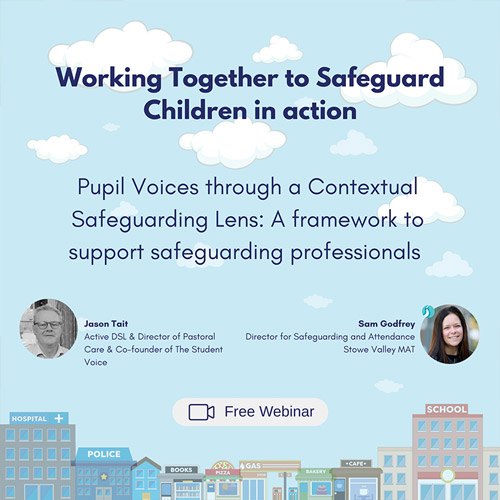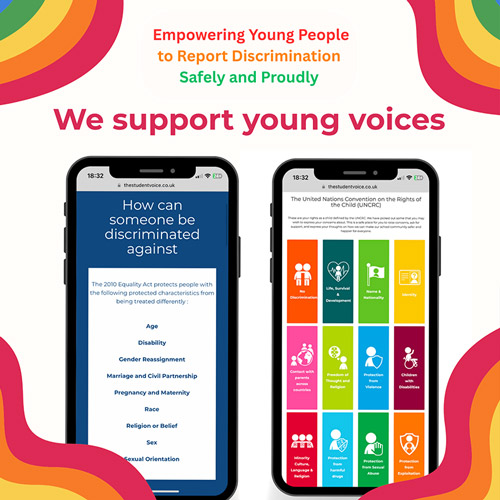Multi Academy Trusts: How can schools benefit from working together
Safeguarding is everybody’s responsibility, so how can we encourage a whole school and whole MAT approach to information sharing?
The ability to share provisions gives multi academy trusts a great advantage through building common policies, sharing expertise, and learning directly from each other. Multi academy trusts that situate in the same area can also benefit greatly from sharing and streamlining safeguarding information to help prioritise and allocate resource better. Whilst multi academy trusts are connected via management, with a programme like The Student Voice, schools can work together and utilise this advantage more effectively to safeguard their students.
The main driver behind The Student Voice is that the main electronic safeguarding systems focus on listening to adults in the community. However, as Dr Carlene Firmin’s (2017) research, Everyone’s Invited, and the Ofsted report into sexual abuse in schools suggests, students may not readily share such information with adults. As a team we always go back to Dr Carlene’s (2020) statement outlining that in order to understand the everyday life experiences of young people and ultimately prevent future harm, we must understand the context of where harm takes place, and the social rules that govern them. In order to do this we need to listen to our young people authentically, which The Student Voice does.
Multi Academy Trusts and the proposed issues they face
Students that finish at one school at 3pm may gather in a local area, or around the gates of another school that has a later school day. Whilst their interest may be socialising, there may be causes for concern when rumours of bullying, theft or safeguarding issues start surfacing.
The equivalent of 530 10 to 15 year olds are suffering theft every day (The Telegraph, 2019), with just 1 in 8 children (13%) in this age group reporting it to the police (ONS, 2019). Those who said they had been subjected to violence jumped to more than one in 20.
Contextual safeguarding research suggests that students may be reluctant to share sensitive safeguarding issues with teachers face to face because their social conditions favour them to stay silent (Carlene Firmin, 2017). As outlined in a previous blog, the data supports the view that for a young person to disclose any form of risk to their own safety or that of their peers takes immense courage and trust.
Students travelling through local areas, sharing the same walks, buses or trains to and from school may have the same negative experiences to share but no way of reporting their concerns, nor the confidence to speak up about these contextual safeguarding matters.
How to Become PRO-active, not RE-active
Empowering students to take ownership of their community and improve their student experience will shape a student body of highly engaged individuals through a positive, proactive approach, and encourage others to speak out about their experiences as they can see they are being listened to.
Giving young people a brave space to confidentially or anonymously share information about issues in the school and local community will empower young voices to come forward, tackle peer on peer issues and develop safer communities for our young people. For example, locations where children feel unsafe, reporting locations and incidents of knife crime, phone theft, drug dealing, and physical assaults. This gives young people the courage and ability to safely report safeguarding issues that concern them.
Going a step further than a hotspot map, with a live data tool will enable schools to prevent future harm by highlighting live hotspots of where students feel safe and unsafe, provides contextual information, including times and dates, and whether the harm is outside of adult supervision. This allows schools and colleges to implement and track interventions to improve these hotspots and prevent future harm.
How MATs can work effectively together and with local authorities, and what that means for the future
Gathering vital reports on hotspot areas, times of day these incidents are occurring, and what age or year groups are experiencing this, means schools and local authorities can work more effectively together to intercept and prevent crime in the area.
This will not only develop safer schools, but also safer communities as the system allows for information to be shared between multi academy trust schools in the same catchment area, and with police and social care. This will allow for proactive safeguarding measures to be in place and the ability to track the effectiveness of measures put in place.
Community Safeguarding has the potential to dramatically improve the way in which education, police and social care can work together to successfully provide safer communities for young people, and educate students to become responsible and active participants in building safer communities. Communities will not only have the opportunity to enhance real-time safeguarding provision, but they will also create phenomenal, positive learning opportunities and experiences for young people to take into adulthood. We recognise the immense potential of investing in young people through providing them with brave spaces. We operate with an awareness of the varied life experiences students have and strive to respect and understand their social rules. This creates a safer community and a safer future for our young people.
The key areas The Student Voice helps schools with are:
- Bridging the student-teacher communication gap with a safe space for students to raise concerns through a visual, interactive reporting system.
- Goes a step further than a hotspot map as this is a live data tool which shows live hotspots, provides contextual information for those hotspots and allows schools to filter and track how interventions are improving those hotspots, and preventing future harm.
- Provide an actionable way for many DSLs to implement a contextual safeguarding, whole-school approach, as it may be difficult to implement
- Feedback from students on the safety of the whole community, including local areas, bus routes, home life, all tailored to the school.
- Collecting positive feedback, which schools haven’t previously known or been able to build upon.
‘Just 1 in 8 children (13%) aged 10 to 15 years old are reporting thefts to the police.’
ONS, 2019





